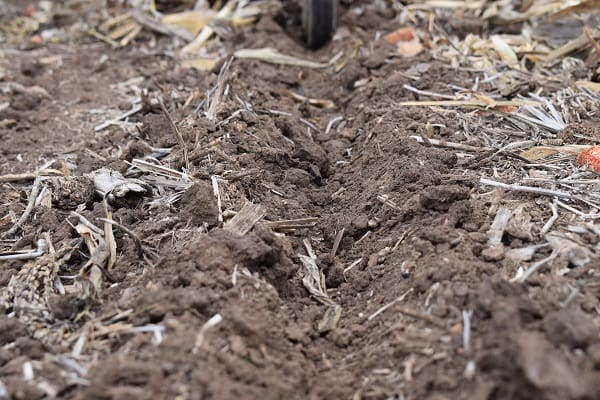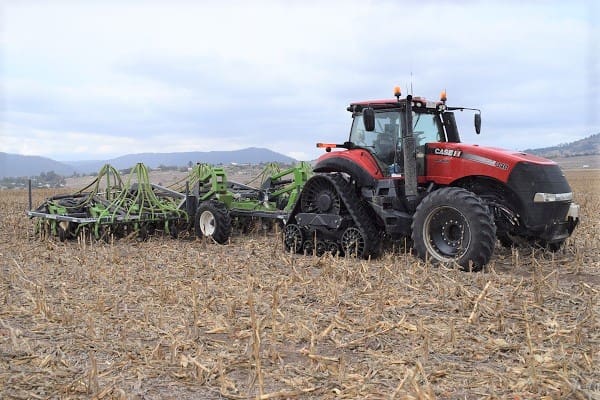
Wayne and Scott Petersen, and their father, Rod, run an integrated cropping program near Killarney on Queensland’s southern Darling Downs.
A FOCUS on summer cropping and a concerted effort to push cropping frequency to 120 per cent underpin the innovative farming program run by the Petersen family on Queensland’s southern Darling Downs.
The Petersens – Rod and Judy, their sons Wayne and Scott and their wives Karen and Sandi – farm 1600 hectares of owned and sharefarmed black soil country across a number of blocks in the Killarney district east of Warwick, where the rainfall average is up to 700 millimetres a year.
Their main crops are corn and soybeans through summer, along with other summer crops of sorghum and mungbeans, and winter crops of wheat, barley and chickpeas. Their preferred rotation is corn, barley, soybeans and back to corn.
Addressing a visiting group of farmers on a Queensland AgForce industry tour, Scott Petersen said the family was always on the lookout for double cropping opportunities where they could go straight in behind the header and plant another crop.
A common example was where, seasons permitting, they followed the harvest of a corn crop with the planting of a barley crop.
“In one paddock we have had seven crops in the last 3.5 years. They were all profitable. That’s what’s achievable given the rainfall.”
“Our cropping frequency is often at least 120 per cent, so we can get two crops in one paddock per year, depending on what area we double crop. For us, double cropping means we harvest and come straight back in. A fallow for us is going from corn and back to corn the following year,” he said.
Mr Petersen said they were always prepared to go in with an opportunity crop if the moisture was there.
“For example, last year we planted 1000 acres (400ha) of chickpeas, wheat and barley straight into corn ground which was only harvested a month or two before. We had mixed results, but it all ended up being profitable. We sprayed out one paddock that was right on the border line when we were planting,” he said.
“In one paddock we have had seven crops in the last 3.5 years. They were all profitable. That’s what’s achievable given the rainfall.
“It is one of our steepest paddocks so we are trying to keep groundcover and something growing there. We are starting to hold that paddock together, whereas there was erosion on it all the time before.”
Farming in an area of elevation and high rainfall in the lee of the Great Dividing Range, the Petersens benefit from wide planting windows.
“We can run from mid-October through to the first week of January for corn; same start through to early December for sorghum; soybeans from mid-November to the first week of January; mung beans in December/January; wheat and barley can go from late May through to mid-July,” Mr Petersen said.
Father, Rod Petersen, was one of the “guinea pigs” for minimum till back in the early 1980s, introducing the system long before it was the thing to do.
The Petersens now maintain a zero till farming system, and have since introduced controlled traffic farming on three-metre-wide wheel centres and nine-metre-wide farming runs.
Being on undulating country with a legacy of extensive contour banks, they are unable to run rigid bar farming equipment. It needs to flex.
Constantly adding greater precision into their farming system, six years ago they introduced auto steer in their tractors and have since adopted implement steer on their planters, a move which has proved invaluable for keeping their trailed equipment on line on the hillsides.
“With implement steering, we have set up the planter so that when we plant barley into corn stubble we are planting a barley row each side of the corn row,” Rod Petersen said.
“The following summer season we aim to be able to come back with soybeans of mungbeans that we plant on the old corn row which, by then, had broken down. It’s in between the two rows of barley, so we don’t have any of the hassle of soybeans or mungbeans trying germinate on the old barley row.
“A number of years ago we were planting on 12-inch row spacing which meant at some stage we were trying to put a row of soybeans or mungbeans on top of a row of barley and it just wasn’t working.
“With summer crop we run on 30-inch rows and winter crop is now 15-inch straddling the rows which allows us to come in behind with a planter without disturbing the stubble. That is where implement steer has played a big part in the last couple of years by keeping everything on line and stopping tynes busting out corn stubbles and blocking.”
The Petersens are also moving down the path of variable rate applications, having set up their equipment for variable rate seed and fertiliser, and using section control on their sprayer.
Scott Petersen said their on-farm storage system had evolved over the past 20 years to now feature a 3000-tonne grain storage and drying complex.
“We quite often have short harvest days. We get dews overnight. We rarely have a harvest where we don’t have to dry grain. Drying is a part of life for us,” he said.
One of the markets the Petersens have tapped into in the last couple of years is high moisture corn going out to the nearby Whyalla feedlot.
“It is harvested at between 25 and 35 per cent moisture. It is trucked to Whyalla where it goes through a roller mill and is treated like silage,” Mr Petersen said.
“It is slightly lower value return for us than the gritting markets, but it has been quite good. It is good to have another market. It gets the crop off the paddock quickly.
“We have a few headaches at harvest with that level of moisture. 30pc is good. Above that you have to clean the header out quite regularly.”
Grain Central: Get our free daily cropping news straight to your inbox – Click here





HAVE YOUR SAY